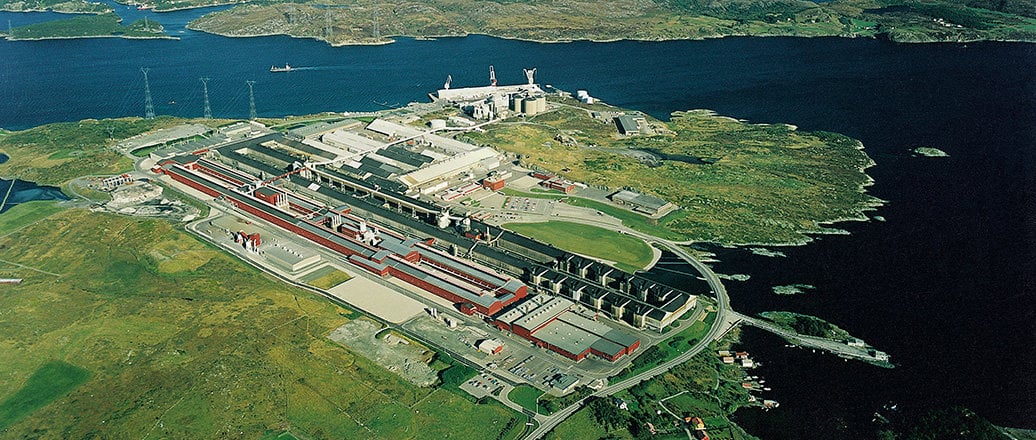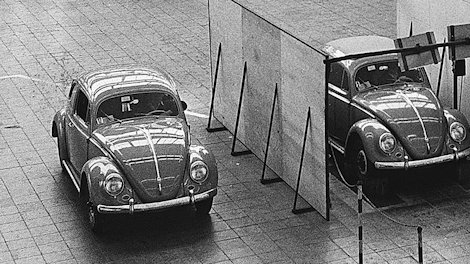Six years earlier, news had been bad: the winter herring had failed for the first time in 50 years. How would the small scale farmers supplement their earnings without the herring fishing?
There were several attempts to establish alternative industry. In the meantime unemployment and discontent spread. The fishing fleet was disbanded, and many of the shipyards were now too small for the increasing tonnage of the merchant fleet. Rationalization in agriculture and fisheries led to further job losses. The oil industry had not yet been conceived.
However, at the end of the 1950s the Oslo newspapers announced that Hydro intended to set up an operation in Rogaland county on the west coast. Two people in particular followed this up: Styrk Fjærtoft, the local policeman in Sveio and the mayor of Tysvær, Ånen Susort. Fjærtoft found out how many people were unemployed in the district and Susort asked Ottar Odland in the Norwegian state broadcasting system to cast the limelight onto Hydro and push for some answers.
Power transmission
But Hydro was not to be hurried. The power supply had to be ensured before any such major decision could be taken. And the amount of power for an industrial site large enough to make a real impact was enormous.
However this could be provided by electricity lines running across the country from east to west. The possibility of transmitting electricity over considerable distances without significant loss meant that industry no longer had to be restricted to narrow waterways. Local politicians supported the use of power from Røldal-Suldal that Hydro had rights to.
The other type of power needed – manpower – was plentiful. Over 1,000 people were looking for working on Karmøy.
In the end local campaigners managed to persuade Hydro’s technical director Rolf Heggenhougen and head of technical building Arne Giæver to choose Håvik on Karmøy as the site of the new plant.
Over to aluminium
But what was Hydro to produce on Karmøy – mineral fertilizer, PVC or aluminium? The question required careful consideration, but the rights to electricity from Røldal-Suldal meant the company had access to power that could be used for more than fertilizer production.
Managing director Rolf Østbye felt aluminium was the obvious choice. But there was opposition from key persons in the Norwegian parliament and administration. One of the strongest opponents was Erik Brofoss, former Minister of Trade and Finance and now head of the Bank of Norway. Bro-foss thought it was nonsense for Hydro to get involved in aluminium when “everyone” knew that the future was in polythene and PVC.
But aluminium it was to be. For the fishermen and farmers on Karmøy, this was the start of a new future: no more setting out to sea in the biting cold of February looking for herring. Work would now follow shifts, which meant keeping different hours. But unlike fishing, the new lifestyle would be predictable.
The Harvey brothers join the scene
This was more or less a new product for Hydro, and a partner had to be found. First they contacted the French company Pechiney, later Canadian Alcan and American Alcoa became candidates. Both were interested in working with Hydro.
Negotiations drew out, and it was finally former UN general secretary Trygve Lie who contacted Harvey Aluminium in California. The company was owned and run by the Harvey brothers, who had built up a significant semi-manufacturing operation in the US.
Hydro could see the advantage of working with a company that was independent, but not too large. The main thing was that Harvey was able to supply sound technology for building up an integrated aluminium operation such as Hydro had in mind.
The agreement with the American brothers resulted in the formation of the company Alnor Aluminium Norway A/S, where Hydro held 51 and Harvey 49 per cent of the shares. The company was registered in the Karmsund Register of Companies on 11 June 1963.
Hydro buy-back
After a ten year partnership with Harvey Aluminum, Alnor became a wholly-owned Hydro subsidiary on 3 May 1973. The purchase price was USD 20 million.
Hydro had wanted to take sole ownership of the Karmøy operation for some time. But it was not unit the Harvey company was purchased by the industry magnate Martin Marietta that this could be realized. Marietta hesitated for a while, but, as mentioned, let Alnor go for USD 20 million. This was hardly a business success for the seller – Hydro earned back the 20 million in just two years!
Metal plates and profiles
The original plan for the Karmøy development was first to build an extrusion plant to produce profiles from purchased metal, and then to follow this with potroom, casthouse and rolling mill. Harvey had good experience from its extrusion plants in the US.
However the extrusion unit was the last to be built, and trial operation started on 14 January 1969. The potroom and rolling mill had begun production on 17 June the previous year. The rolling mill was small compared to its European counterparts, but was the first of its kind in that it used molten metal from the adjoining potroom.
The rolling mill was also based on Harvey technology and the strip cast method. The results were good for the first years, but business cycles caused problems. There were periods during which management would have preferred to produce ingots than raw band and thin plates.
Aluminium to Europe
The first shipment of aluminium from Karmøy set course for China, but it was in the European market that it gained the greatest foothold. The European aluminium industry in the sixties was mainly based on the national tariff barriers within the EEC and EFTA.
Hydro chose to focus on setting up sales offices in EFTA, and these sprouted up one after the other in London, Manchester, Bad Dürkheim and Helsinki. These office were set up to sell profiles, rolled products and wire rod, and were under the absolute control of Karmøy. They also helped Al-nor Aluminium Norway A/S to become an international aluminium company.
However setting up a sales organization was not a simple matter. These were technical products that the sellers needed to know and understand. So Alnor encouraged engineers and metallurgists to take up sales work in a serious way.
Competitors in Europe were by no means delighted to have a newcomer in the market. They tried to obstruct Alnor’s progress, and the EEC applied anti-dumping measures to make the Karmøy plant cut production during periods of over-production. But to no avail. While other companies cut back 10-20 per cent, Alnor ran at full capacity. And sold its metal.
Volume increases to European top
From a humble beginning as a problematic plant with limited production volume, Alnor, later renamed Karmøy Fabrikker, entered a new category of electrolysis plant due to two extensions. The first was the KIII extension. Hydro applied for a power concession for the extension in 1974, but had to wait until 1978 for the go-ahead.
Hydro’s corporate assembly approved the KII development in September 1980. This meant an increase in capacity of around 50,000 tonnes from 110,000 tonnes to 162,000 tonnes.
One of the reasons behind the development was forecasts indicating that there would be a shortage of metal in the 1980s. Hydro also wanted to take part in the development of Norwegian industry. But perhaps equally important was the fact that the company needed more metal in its own semi-manufacturing facilities in Europe.
Now was the time to choose what technology to invest in. The recommendation was for the French Pechiney system with closed electrolysis cells equipped with baked anodes, which had strong environmental advantages. A total of 108 Pechiney cells were ready in 1982, and capacity increased to 162,000 tonnes.
The next stage in the extension process, K4, took place in 1987. A further capacity increase of 55,000 tonnes brought production volume up to 220,000 tonnes. This made the Karmøy facility the largest metal plant in Europe at the time.
Updated: August 18, 2020








